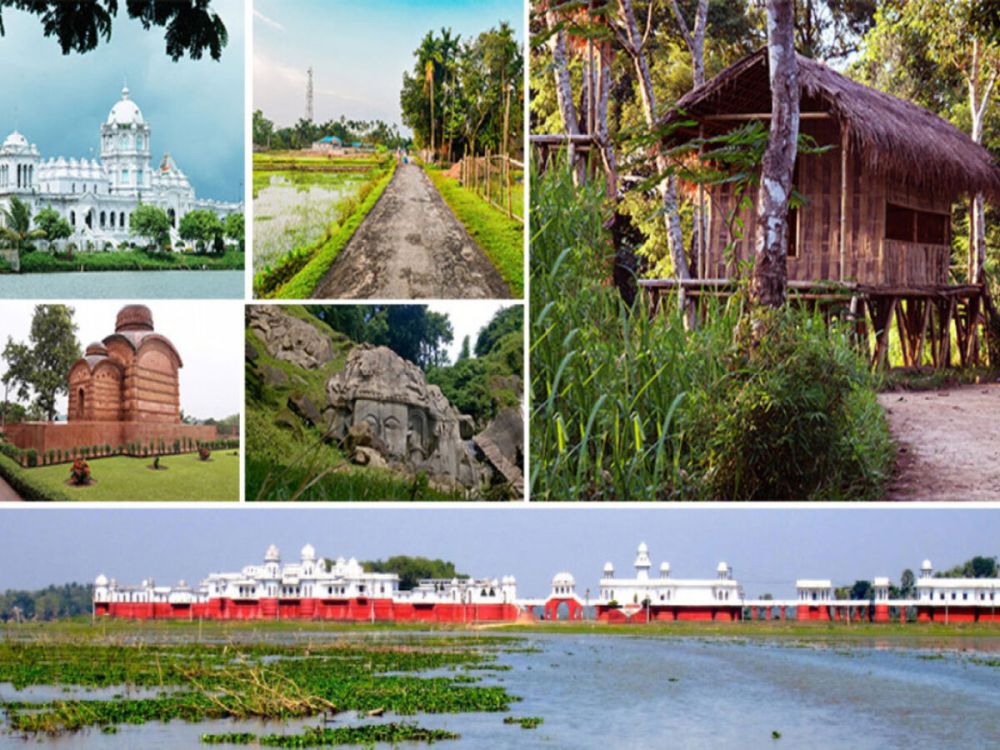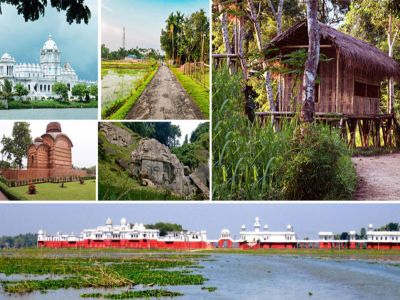

Neermahal, situated in the Rudrasagar Lake, is the largest water palace in India. The Neermahal Water Festival, held annually, showcases the rich cultural heritage of Tripura. It's a vibrant spectacle that includes boat races, traditional dance performances, and exhibitions. At the Neermahal Water Festival, you get to explore the magnificent palace, which is a blend of Hindu and Islamic architecture, as you take in the festivities. Visitors can also enjoy the local cuisine and shop for handicrafts. The festival is not only a splendid display of culture but also an opportunity to learn about the history of the royal families of Tripura. The duration of the festival usually spans over two to three days and is a period of joy and celebration for locals and tourists alike.
The Tripura Sundari Temple, also known as Matabari, is one of the 51 Shakti Peethas and is located in the ancient city of Udaipur, about 55 km from Agartala. It is revered as one of the holiest Hindu shrines in this region. The temple, with its iconic architecture and spiritual ambiance, attracts pilgrims and tourists from across the globe. An approximate 150-word description might talk about the temple's history, its religious significance, the serene lake adjacent to it, and the traditional rituals performed there. Visitors can learn about the local legends and observe the daily pujas. The trip including travel time could take half a day to a full day, depending on where you're coming from and how long you wish to spend at the temple.
Unakoti means 'one less a koti' in Bengali, and it's an archaeological wonder located in the lush greenery of Tripura. Unakoti is home to ancient rock carvings and murals dating back to the 7th to 9th centuries. It is shrouded in mystery and legend, with numerous stories about its origin. The site features colossal stone and rock-cut images of Lord Shiva, and a visit here is akin to stepping into a different era. The intricate carvings on the rocks, and the natural waterfall nearby create a serene atmosphere. Tourists can explore the site and learn about the mythological stories tied to this place. The guided tour of Unakoti can typically last for about 2-4 hours, and it's an experience unlike any other for history and culture enthusiasts.
Located in the heart of Agartala, Heritage Park is a place that pays tribute to the rich cultural and ecological heritage of Tripura. Spread over 12 acres of land, visitors can enjoy a walk through mini-Tripura, showcasing replicas of the state’s diverse tribal huts and historical structures. It's a place perfect for familiarizing yourself with the state's architecture and lifestyles of the indigenous people. The park also offers beautiful green spaces for relaxation and a pond with boating facilities. It's a great location for families and individuals who wish to spend a few hours in tranquility, away from the bustle of the city. A trip to the Heritage Park, including leisure time, could take up to 2-3 hours.
Chabimura is set along the Gomati River and is famous for its 15th-16th-century rock carvings depicting Hindu gods and goddesses. These carvings were etched directly into the steep mountain walls. You can take a boat trip to view these incredible carvings closely and enjoy the pristine beauty of the river and the surrounding forest. Chabimura is a perfect destination for adventure seekers and history buffs. After the boat ride, you can have a picnic on the riverbanks, immersed in the area's natural beauty. The entire trip, including travel, boating, and picnic, could take a full day, offering a unique blend of culture, history, and natural splendor.
The Tripura Government Museum is a treasure trove of the state’s history and culture, located in Agartala. It houses a diverse collection of ethnographic objects, tribal art, sculptures, textiles, and archaeological findings from the region. The museum provides a in-depth insight into Tripura's past, from its princely states era to the present day. Visitors can spend hours delving into the exhibits that narrate stories of the bygone years. Alongside the historical artifacts, the museum often hosts cultural events and educational programs. Exploring the museum could take around 2 hours, which is a must-visit for those looking to acquaint themselves with the rich heritage of Tripura.
Sepahijala Wildlife Sanctuary is a biodiversity haven offering a safari experience that brings you close to the diverse flora and fauna of Tripura. It is spread over an area of 18.53 square kilometers and is home to various species including the unique spectacle monkey, clouded leopards, and barking deer. The sanctuary also features a botanical garden, zoo, and several lakes. Birdwatchers will find Sepahijala particularly enchanting, as it's home to a rich variety of avian life. Visitors can enjoy boating in the lakes or take a guided nature walk to learn about the ecological significance of the region. The safari and other activities can take about 3-4 hours to enjoy thoroughly.
The Kamalasagar Kali Temple sits on the banks of the Kamalasagar Lake, near the Bangladesh border. It was built in the 15th century and is dedicated to the Goddess Kali. The serene ambiance of the temple, combined with the panoramic vista of the lake, makes this place not just a religious site but also a locale of exquisite natural beauty. The temple reflects the unique architectural style prevalent in Tripura and Bengali influences. Devotees and tourists can attend the daily rituals and enjoy a peaceful boating experience on the lake. A visit to Kamalasagar Kali Temple, including travel, darshan, and lake activities, may last about half-day.
Located on the banks of the Gomati River in Udaipur, Tripura, Bhubaneswari Temple is an 17th-century temple with a rich historical background. It has been referenced in Rabindranath Tagore's work, adding to its cultural significance. The temple premises offer a quiet and reflective atmosphere, making it an ideal place for spiritual seekers as well as history enthusiasts. The architecture of Bhubaneswari Temple is a fine example of the charchala style present in Bengali temple architecture. Visitors can explore the temple complex, attend the daily puja ceremonies, and enjoy the serene setting by the river. Touring the site might take around 1-2 hours.
Known as the 'Eternal Hills of Spring', Jampui Hills are Tripura's highest hill range and provide an enthralling experience for trekkers and nature lovers. The hills are covered with lush forests and orchards, especially well-known for their orange plantations. Trekking through Jampui Hills offers breathtaking panoramic views of the hills and the valleys below, with glimpses of the Mizoram borderline. The region also provides an insight into the culture and lifestyle of the local Lushai and Reang tribal communities. Depending on the trail and speed, a trekking excursion can last from a few hours to an entire day, offering various experiences from casual walks to more strenuous hikes.
